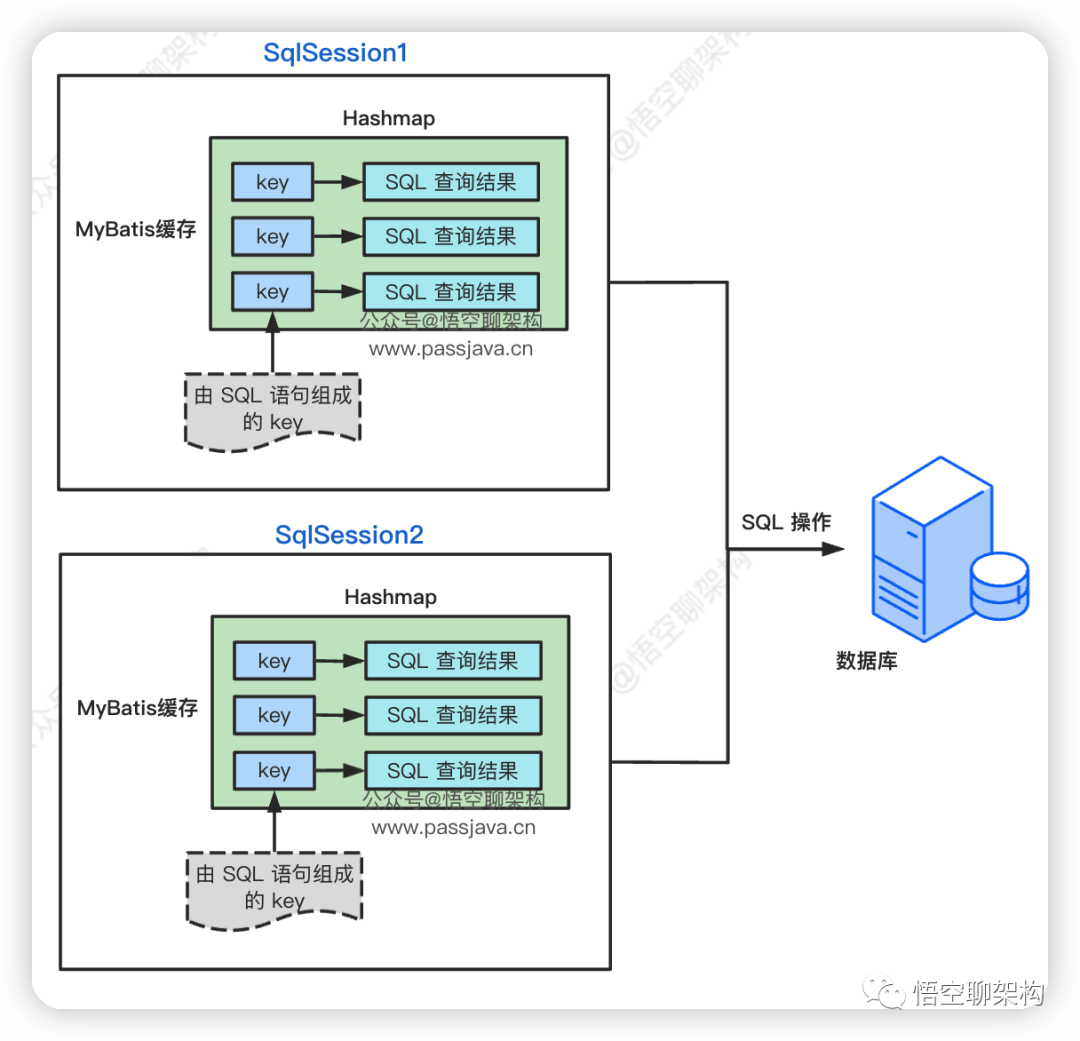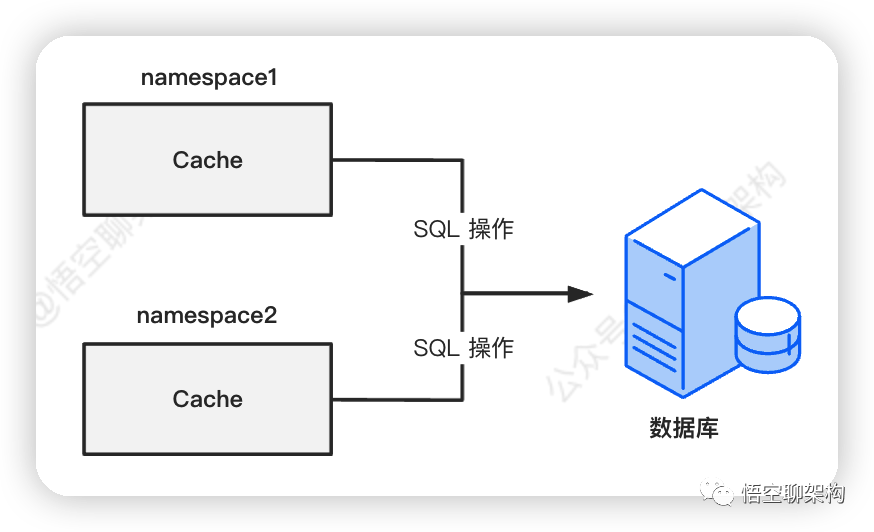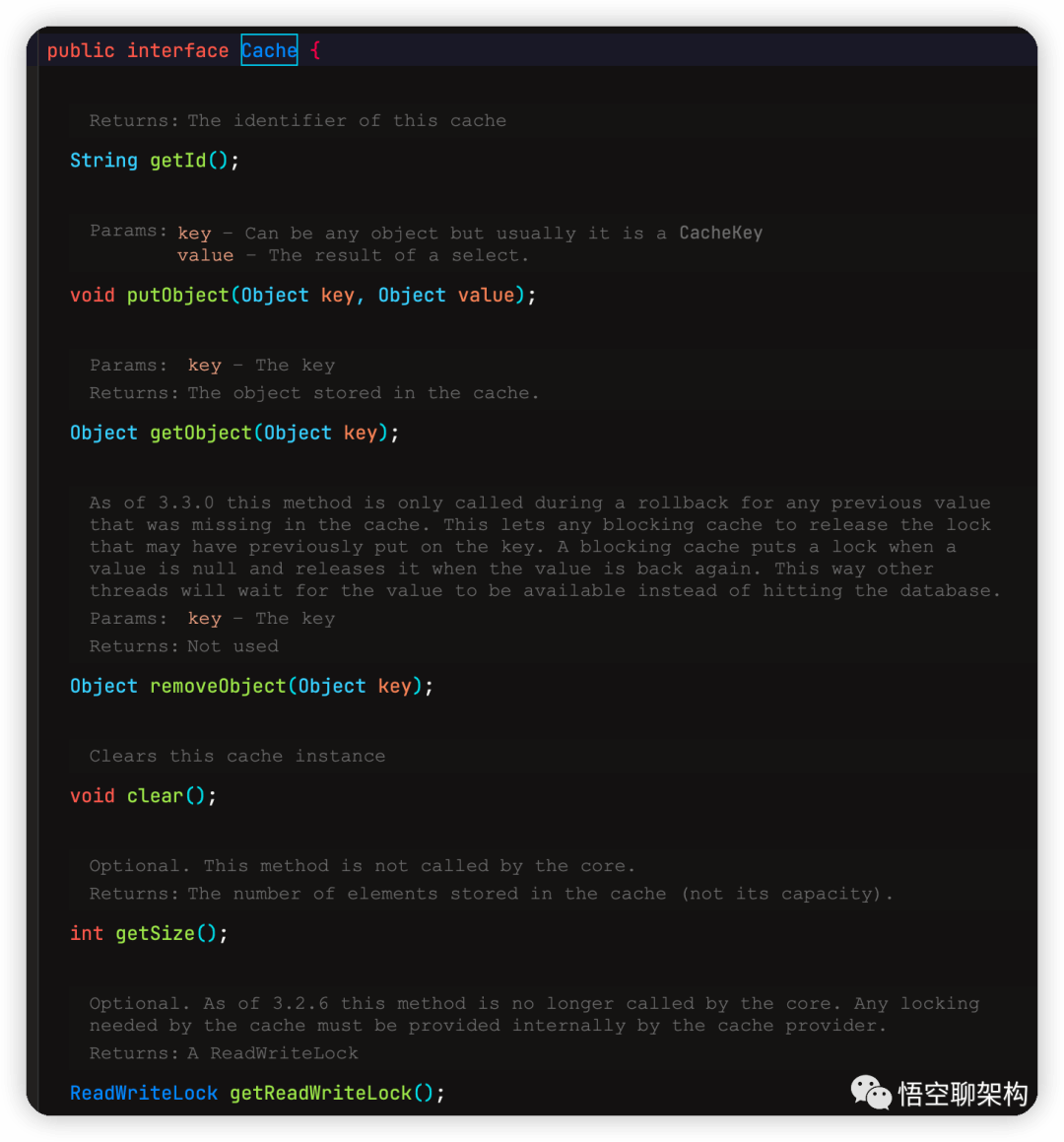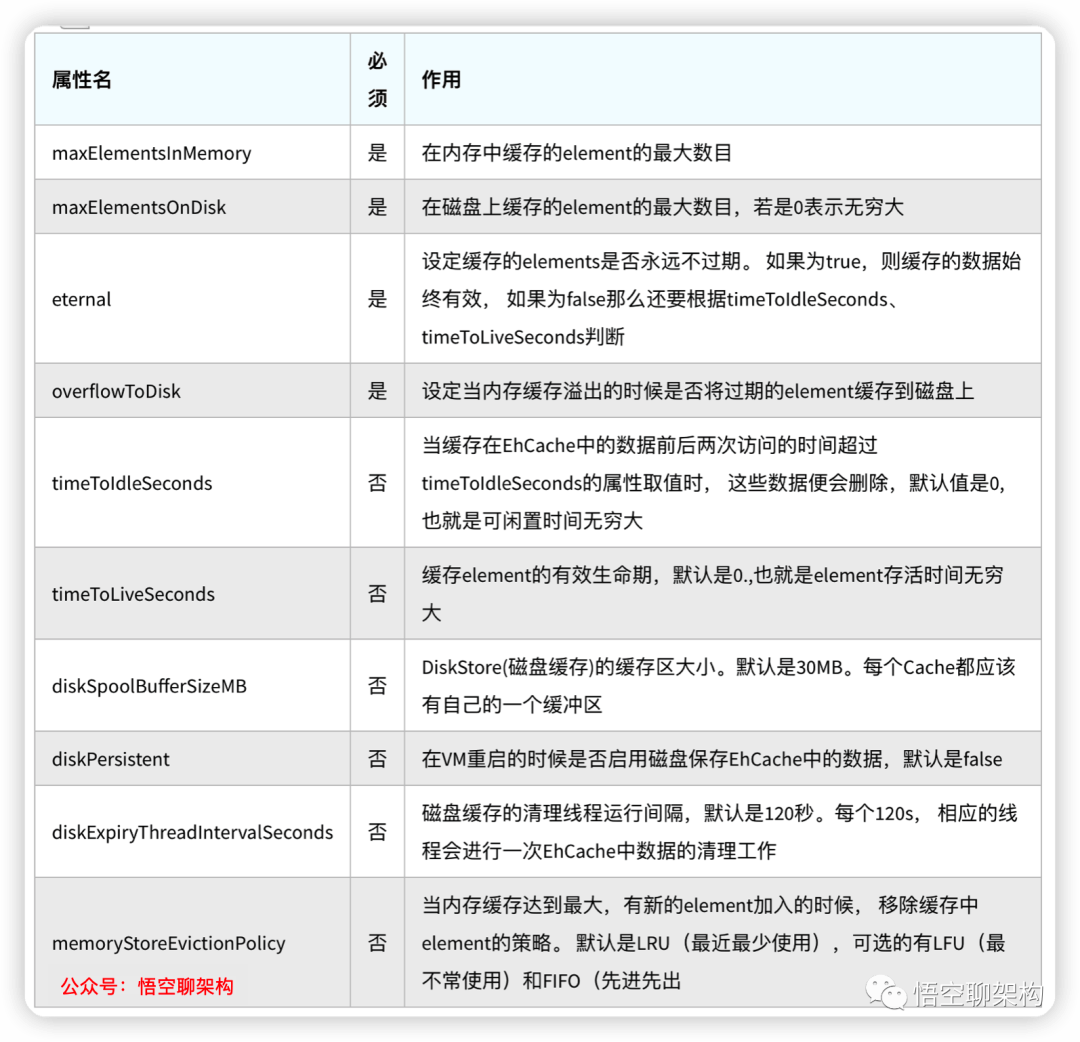图解 | 聊聊 MyBatis 缓存原创
你好,我是悟空。
本文主要内容如下:
一、MyBatis 缓存中的常用概念
- MyBatis 缓存:它用来优化 SQL 数据库查询的,但是可能会产生脏数据。
- SqlSession:代表和数据库的一次会话,向用户提供了操作数据库的方法。
- MappedStatement:代表要发往数据库执行的指令,可以理解为是 SQL 的抽象表示。
- Executor:代表用来和数据库交互的执行器,接受 MappedStatment 作为参数。
- namespace:每个 Mapper 文件只能配置一个 namespace,用来做 Mapper 文件级别的缓存共享。
- 映射接口:定义了一个接口,然后里面的接口方法对应要执行 SQL 的操作,具体要执行的 SQL 语句是写在映射文件中。
- 映射文件:MyBatis 编写的 XML 文件,里面有一个或多个 SQL 语句,不同的语句用来映射不同的接口方法。通常来说,每一张单表都对应着一个映射文件。
二、MyBatis 一级缓存
2.1 一级缓存原理
在一次 SqlSession 中(数据库会话),程序执行多次查询,且查询条件完全相同,多次查询之间程序没有其他增删改操作,则第二次及后面的查询可以从缓存中获取数据,避免走数据库。
每个SqlSession中持有了Executor,每个Executor中有一个LocalCache。当用户发起查询时,MyBatis根据当前执行的语句生成MappedStatement,在Local Cache进行查询,如果缓存命中的话,直接返回结果给用户,如果缓存没有命中的话,查询数据库,结果写入Local Cache,最后返回结果给用户。
Local Cache 其实是一个 hashmap 的结构:
private Map<Object, Object> cache = new HashMap<Object, Object>();
如下图所示,有两个 SqlSession,分别为 SqlSession1 和 SqlSession2,每个 SqlSession 中都有自己的缓存,缓存是 hashmap 结构,存放的键值对。
键是 SQL 语句组成的 Key :
Statement Id + Offset + Limmit + Sql + Params
值是 SQL 查询的结果:
2.2 一级缓存配置
在 mybatis-config.xml 文件配置,name=localCacheScope,value有两种值:SESSION 和 STATEMENT
<configuration>
<settings>
<setting name="localCacheScope" value="SESSION"/>
</settings>
<configuration>
- SESSION:开启一级缓存功能
- STATEMENT:缓存只对当前执行的这一个 SQL 语句有效,也就是没有用到一级缓存功能。
首先我们通过几个考题来体验下 MyBatis 一级缓存。
2.3 一级缓存考题
考题1:只开启了一级缓存,下面的代码调用了三次查询操作 getStudentById,请判断,下列说法正确的是?
// 打开一个 SqlSession
SqlSession sqlSession = factory.openSession(true);
StudentMapper studentMapper = sqlSession.getMapper(StudentMapper.class);
// 根据 id=1 查询学生信息
System.out.println(studentMapper.getStudentById(1));
// 根据 id=1 查询学生信息
System.out.println(studentMapper.getStudentById(1));
// 根据 id=1 查询学生信息
System.out.println(studentMapper.getStudentById(1));
答案:第一次从数据库查询到的数据,第二次和第二次从 MyBatis 一级缓存查询的数据。
解答:第一次从数据库查询后,后续查询走 MyBatis 一级缓存
考题2:只开启了一级缓存,下面代码示例中,开启了一个 SqlSession 会话,调用了一次查询,然后对数据进行了更改,又调用了一次查询,下列关于两次查询的说法,正确的是?
// 打开一个 SqlSession
SqlSession sqlSession = factory.openSession(true);
StudentMapper studentMapper = sqlSession.getMapper(StudentMapper.class);
// 根据 id=1 查询学生信息
System.out.println(studentMapper.getStudentById(1));
// 插入了一条学生数据,改变了数据库
System.out.println("增加了" + studentMapper.addStudent(buildStudent()) + "个学生");
// 根据 id=1 查询学生信息
System.out.println(studentMapper.getStudentById(1));
sqlSession.close();
答案:第一次从数据库查询到的数据,第二次从数据库查询的数据
解答:第一次从数据库查询后,后续更新(包括增删改)数据库中的数据后,这条 SQL 语句的缓存失效了,后续查询需要重新从数据库获取数据。
考题3:当开启了一级缓存,下面的代码中,开启了两个 SqlSession,第一个 SqlSession 查询了两次学生 A 的姓名,第二次 SqlSession 更新了一次学生 A 的姓名,请判断哪个选项符合最后的查询结果。
SqlSession sqlSession1 = factory.openSession(true);
SqlSession sqlSession2 = factory.openSession(true);
StudentMapper studentMapper = sqlSession1.getMapper(StudentMapper.class);
StudentMapper studentMapper2 = sqlSession2.getMapper(StudentMapper.class); studentMapper2.updateStudentName("B",1);
System.out.println(studentMapper.getStudentById(1));
System.out.println(studentMapper2.getStudentById(1));
答案:
A
B
解答:只开启一级缓存的情况下,SqlSession 级别是不共享的。代码示例中,分别创建了两个 SqlSession,在第一个 SqlSession 中查询学生 A 的姓名,第二个 SqlSession 中修改了学生 A 的姓名为 B,SqlSession2 更新了数据后,不会影响 SqlSession1,所以 SqlSession1 查到的数据还是 A。
2.4 MyBatis 一级缓存失效的场景
不同的SqlSession对应不同的一级缓存
同一个SqlSession但是查询条件不同
同一个SqlSession两次查询期间执行了任何一次增删改操作
同一个SqlSession两次查询期间手动清空了缓存
2.5 MyBatis 一级缓存总结
MyBatis一级缓存内部设计简单,只是一个没有容量限定的 HashMap,在缓存的功能性上有所欠缺
MyBatis的一级缓存最大范围是SqlSession内部,有多个SqlSession或者分布式的环境下,数据库写操作会引起脏数据,建议设定缓存级别为Statement
一级缓存的配置中,默认是 SESSION 级别,即在一个MyBatis会话中执行的所有语句,都会共享这一个缓存。
三、MyBatis 二级缓存
3.1 MyBatis 二级缓存概述
MyBatis的二级缓存相对于一级缓存来说,实现了SqlSession之间缓存数据的共享,同时粒度更加的细,能够到namespace级别,通过Cache接口实现类不同的组合,对Cache的可控性也更强。
MyBatis在多表查询时,极大可能会出现脏数据,有设计上的缺陷,安全使用二级缓存的条件比较苛刻。
在分布式环境下,由于默认的MyBatis Cache实现都是基于本地的,分布式环境下必然会出现读取到脏数据,需要使用集中式缓存将 MyBatis的Cache 接口实现,有一定的开发成本,直接使用Redis、Memcached 等分布式缓存可能成本更低,安全性也更高。
3.2 MyBatis 二级缓存原理
一级缓存最大的共享范围就是一个 SqlSession 内部,如果多个 SqlSession 之间需要共享缓存,则需要使用到二级缓存。
开启二级缓存后,会使用 CachingExecutor 装饰 Executor,进入一级缓存的查询流程前,先在CachingExecutor 进行二级缓存的查询。
二级缓存开启后,同一个 namespace下的所有操作语句,都影响着同一个Cache。
每个 Mapper 文件只能配置一个 namespace,用来做 Mapper 文件级别的缓存共享。
<mapper namespace="mapper.StudentMapper"></mapper>
二级缓存被同一个 namespace 下的多个 SqlSession 共享,是一个全局的变量。MyBatis 的二级缓存不适应用于映射文件中存在多表查询的情况。
通常我们会为每个单表创建单独的映射文件,由于MyBatis的二级缓存是基于namespace的,多表查询语句所在的namspace无法感应到其他namespace中的语句对多表查询中涉及的表进行的修改,引发脏数据问题。
3.3 MyBatis缓存查询的顺序
先查询二级缓存,因为二级缓存中可能会有其他程序已经查出来的数据,可以拿来直接使用
- 如果二级缓存没有命中,再查询一级缓存
- 如果一级缓存也没有命中,则查询数据库
SqlSession关闭之后,一级缓存中的数据会写入二级缓存。
3.4 二级缓存配置
开启二级缓存需要在 mybatis-config.xml 中配置:
<settingname="cacheEnabled"value="true"/>
3.5 二级缓存考题
测试update操作是否会刷新该namespace下的二级缓存。
开启了一级和二级缓存,通过三个SqlSession 查询和更新 学生张三的姓名,判断最后的输出结果是什么?
SqlSession sqlSession1 = factory.openSession(true);
SqlSession sqlSession2 = factory.openSession(true);
SqlSession sqlSession3 = factory.openSession(true);
StudentMapper studentMapper = sqlSession1.getMapper(StudentMapper.class);
StudentMapper studentMapper2 = sqlSession2.getMapper(StudentMapper.class);
StudentMapper studentMapper3 = sqlSession3.getMapper(StudentMapper.class); System.out.println("studentMapper读取数据: " + studentMapper.getStudentById(1));
sqlSession1.commit();
System.out.println("studentMapper2读取数据: " + studentMapper2.getStudentById(1)); studentMapper3.updateStudentName("李四",1);
sqlSession3.commit();
System.out.println("studentMapper2读取数据: " + studentMapper2.getStudentById(1));
答案:
张三
张三
李四
解答:三个 SqlSession 是共享 MyBatis 缓存,SqlSession2 更新数据后,MyBatis 的 namespace 缓存(StudentMapper) 就失效了,SqlSession2 最后是从数据库查询到的数据。
四、MyBatis 自定义缓存
4.1 MyBatis 自定义缓存概述
当 MyBatis 二级缓存不能满足要求时,可以使用自定义缓存替换。(较少使用)
自定义缓存需要实现 MyBatis 规定的接口:org.apache.ibatis.cache.Cache。这个接口里面定义了 7 个方法,我们需要自己去实现对应的缓存逻辑。
4.2 整合第三方缓存 EHCache
EHCache 和 MyBatis 已经帮我们整合好了一个自定义缓存,我们可以直接拿来用,不需要自己去实现 MyBatis 的 org.apache.ibatis.cache.Cache 接口。
添加 mybatis-ehcache 依赖包。
<dependency>
<groupId>org.mybatis.caches</groupId>
<artifactId>mybatis-ehcache</artifactId>
<version>1.2.1</version>
</dependency>
创建EHCache的配置文件ehcache.xml。
<?xml version="1.0" encoding="utf-8" ?>
<ehcache xmlns:xsi="http://www.w3.org/2001/XMLSchema-instance"
xsi:noNamespaceSchemaLocation="../config/ehcache.xsd">
<!-- 磁盘保存路径 -->
<diskStore path="D:\passjava\ehcache"/>
<defaultCache
maxElementsInMemory="1000"
maxElementsOnDisk="10000000"
eternal="false"
overflowToDisk="true"
timeToIdleSeconds="120"
timeToLiveSeconds="120"
diskExpiryThreadIntervalSeconds="120"
memoryStoreEvictionPolicy="LRU">
</defaultCache>
</ehcache>
设置二级缓存的类型,在xxxMapper.xml文件中设置二级缓存类型
<cache type=“org.mybatis.caches.ehcache.EhcacheCache”/>
4.3 EHCache配置文件说明
五、总结
本篇分别介绍了 MyBatis 一级缓存、二级缓存、自定义缓存的原理和使用,其中还穿插了 4 道考题来验证 MyBatis 缓存的功能。不足之处是 MyBatis 缓存源码未分析。
参考资料:
https://tech.meituan.com/2018/01/19/mybatis-cache.html
-END-
关于我
8 年互联网开发经验,擅长微服务、分布式、架构设计。目前在一家大型上市公司从事基础架构和性能优化工作。
InfoQ 签约作者、蓝桥签约作者、阿里云专家博主、51CTO 红人。










